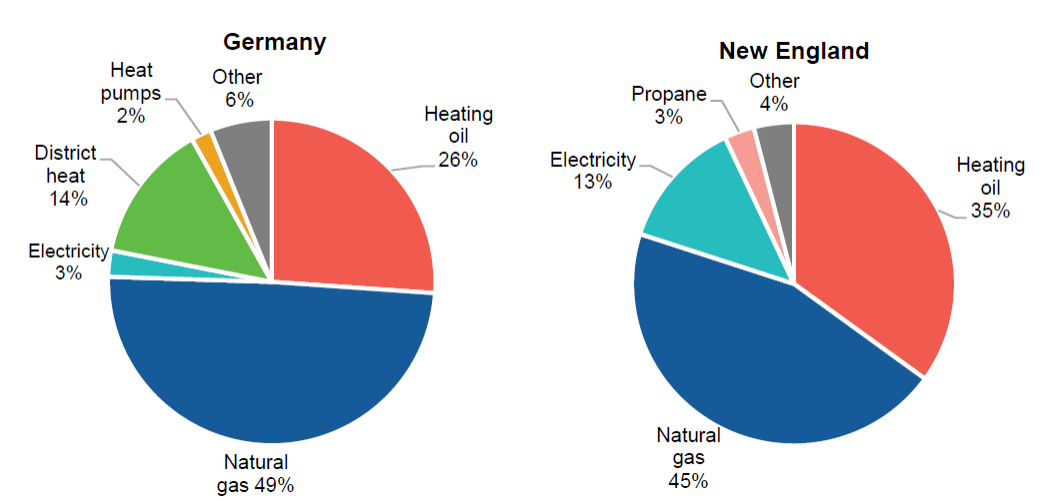
By Guest Contributor | Wed, July 31, 19
This blog was written by David Farnsworth and Dr. Jan Rosenow of Regulatory Assistance Project, and represents the organization's work and approach. Building Decarb Central is meant to share different perspectives on the topic of building decarbonization. This blog is part of that dialogue.
Despite being an ocean apart, Germany and New England are similar in many respects. More than 75 percent of energy used for residential heat in both places relies on natural gas or heating oil. And both have adopted ambitious energy and climate goals — Germany committing to cutting carbon emissions from buildings by two-thirds below 1990 levels by 2030, and the New England states largely adopting targets calling for reductions in the range of 70-80 percent below 1990 levels by 2050. Both are also global leaders in energy efficiency, evident in their similar transition away from fossil fuel heating.
 In our recent paper, “Decarbonizing heat in buildings – a comparison of policies in Germany and New England,” RAP explores the similar approaches adopted in these jurisdictions to retrofit existing building stock with low-carbon heating technologies and upgrade building energy performance.
In our recent paper, “Decarbonizing heat in buildings – a comparison of policies in Germany and New England,” RAP explores the similar approaches adopted in these jurisdictions to retrofit existing building stock with low-carbon heating technologies and upgrade building energy performance.
We start out by recognizing the importance of policy support for decarbonizing building heating — first, because most of the buildings in New England and Germany that will be occupied in 2050 have already been built; and second, because this activity, by its nature, will be disruptive for building occupants, subject to high transaction costs and relatively expensive.
Policy Approaches
Both Germany and the New England states have deployed a variety of policy approaches to drive decarbonization of space heating. Described in detail in the paper, they include:
- Building codes: European Union member states must establish national building codes set by the EU’s Energy Performance of Buildings Directive. Builders in the New England states likewise must meet building energy performance specified by the International Energy Conservation Code for residential buildings. Germany and one of the New England states, Maine, have also adopted time-of-sale energy performance disclosure standards for buildings. Furthermore, a number of New England states have adopted voluntary net-zero energy building standards.
- Appliance standards: Heating systems in Germany are subject to EU regulation under the Eco-design Directive, which sets minimum performance standards for boilers and heat pumps. The U.S. Department of Energy and the Environmental Protection Agency periodically update appliance standards for furnaces and water heaters, enabling purchasers in the New England states and elsewhere to capture significant energy savings. The U.S. Department of Energy’s standards require appliances to meet certain efficiency levels, while the Environmental Protection Agency’s voluntary Energy Star program encourages even greater efficiency.
- Weatherization programs: Every major study of pathways for heat decarbonization demonstrates the need for substantial improvements in building shell integrity. Germany’s most prominent and long-standing building energy efficiency finance efforts are administered by the public bank Kreditanstalt für Wiederaufbau, which provides low-interest loans and grants for energy-efficient refurbishment and construction, including projects designed to integrate with the latest building codes. The New England states are supported by the federal Weatherization Assistance Program (WAP), which enables low-income families to reduce their energy bills by making their homes more energy-efficient. A number of New England states have developed programs to augment or reinforce low-income WAP funding and expand building refurbishment efforts.
- Low-carbon and renewable heating programs: International experience shows that replacing fossil fuel-based heating with low-carbon alternatives can also stimulate demand for both heat pumps. Germany’s Market Incentive Program is the central funding mechanism for expanding the use of renewable energy in the building sector, and for including technologies like heat pumps. New England states have also promoted electrification by providing incentives for heat pumps with other energy efficiency measures.
- Energy efficiency resource standards: Energy efficiency resource standards (EERS), or “energy efficiency obligations” as they are known in Europe, set savings targets that retail distributors of electricity or natural gas must meet, and have contributed to significant carbon emissions reductions in the New England states.* An EERS typically requires an annual percentage reduction or cumulative reduction of energy over a given time period, whether measured in kilowatt-hours for electricity or therms for natural gas. Greater adoption of electrification, however, which increases electricity use while decreasing carbon emissions, may require these metrics for EERS to be revised.
- Carbon revenue recycling: Secure funding of building decarbonization programs is one key to ensuring their effectiveness. Germany and nearly all of the New England states allocate over half of the carbon allowance auction revenues from their cap-and-trade programs to cost-effectively support end-use energy efficiency and decarbonization goals. Germany’s revenues come from the European Union’s Emissions Trading System, while New England participates in the Regional Greenhouse Gas Initiative (RGGI). Both places have found that this investment yields multiple dividends: securing additional emissions reductions, lowering economic and societal decarbonization costs, providing a wide range of non-energy benefits (including improvements in health, comfort, air quality, public housing and welfare costs, job creation and economic growth), and supporting the political processes associated with tightening the emissions cap.
Lessons Learned
One key insight in “Decarbonizing Heat in Buildings” is that retrofitting buildings for energy and carbon reductions is challenging because it depends on affirmative decisions made by millions of individuals, most of whom actually live in the buildings that require improvement. Many market barriers must be overcome, so well-designed, customer-focused programs are needed. Even the best programs have to address information needs, trust issues, financing, and quality assurance issues.
The use of carbon revenues to fund building efficiency programs makes sense, and experience in both regions is positive, supporting, for example, pivotal low-interest loan programs for driving deep retrofits in Germany. The explicit link to building codes is a forward-looking approach to policy integration. Energy efficiency resource standards in Europe and New England are also a key policy instrument. With revision, they can readily encourage electrification, and will continue to be one of the most effective and economically efficient ways of funding end-use energy efficiency.
Both regions recognize the importance of policy continuity and innovation to support the market for low-carbon heating. Both end-use customers (building owners) and efficiency and heating contractors need stable programs and funding in order to identify, plan, market, and deliver renovations. Germany and New England have long-standing policies and long-term targets for decarbonization in place, but policy innovation is required to reap the benefits of efficiency programs as technologies and markets continue to evolve. The improving capabilities of heat pumps is a prime example, but by no means the only one. Not surprisingly, Germany and New England have both modified their policies over time to account for technological improvements.
Finally, “Decarbonizing Heat in Buildings” draws several conclusions regarding electrification. First, electrification requires a holistic approach to designing building codes and appliance standards. Electrification also requires programmatic assistance to retrofit heating appliances. Experience in both Germany and New England shows that, without this support, uptake rates remain low. These lessons will be valuable not only for policymakers in New England and Germany, but also for those working on policy design and implementation elsewhere.
*An earlier version of this blog incorrectly framed Germany's approach to energy efficiency obligations; it does not have such an obligation in place.
This blog is part of Building Decarb Central, a series of blogs and other resources aimed at providing a constant flow of information on building decarbonization. Be sure to check out our web portal for more stories, resources, and information.
